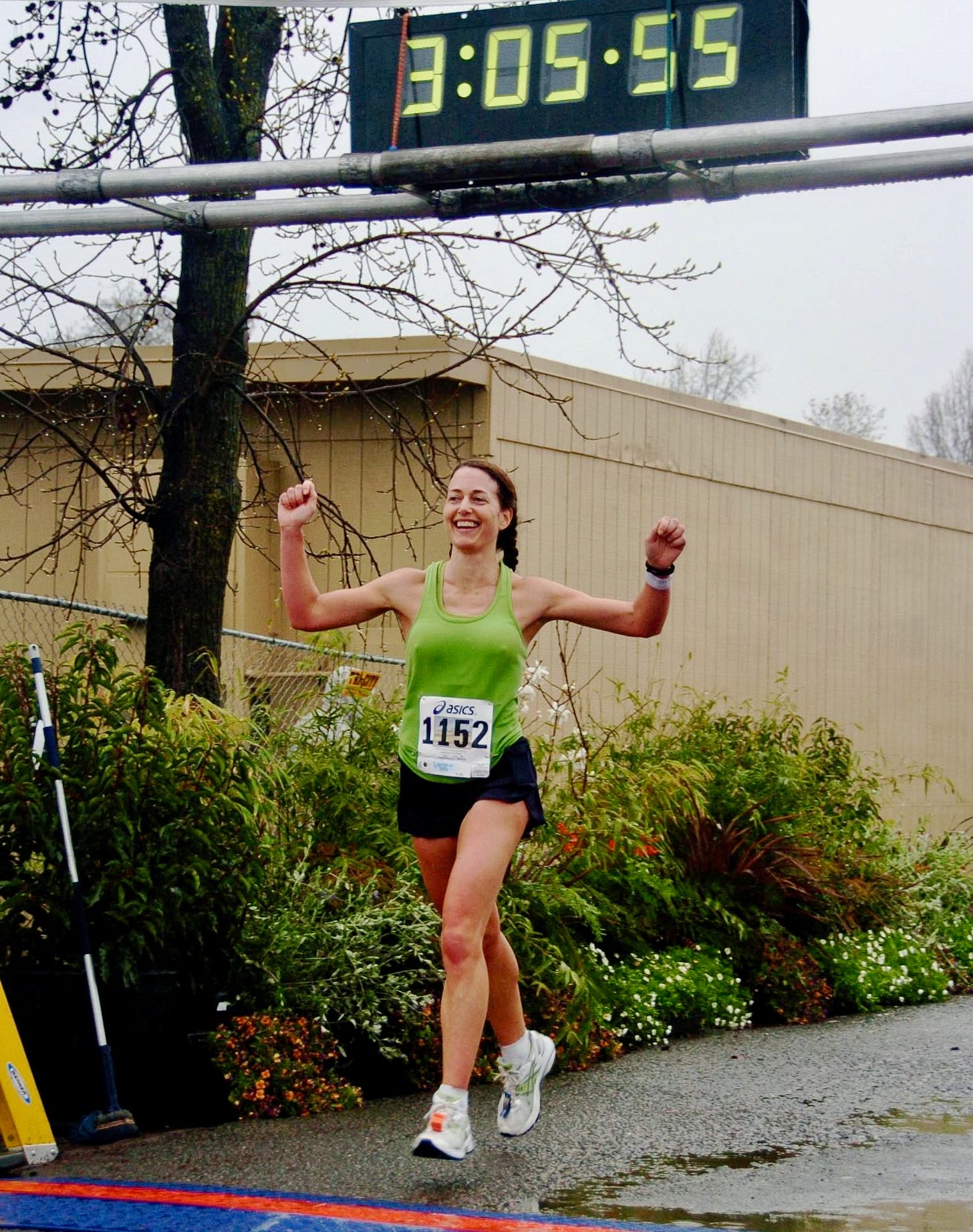Welcome back! This week, I detour from mountain trails to practical road-running guidance. If that doesn’t interest you, please scroll down and don’t miss a couple of recommendations at the end.

The text came with endearing politeness.
“Hi, Mrs. Lavender Smith, it’s”—followed by his name. Then he wrote a reminder of who he is, the son of a friend from high school. Of course, I remembered him. “I signed up for the Boulder Marathon next fall and am starting my training. I was hoping you might shoot me some advice and recommendations for how to prepare.”
I almost swooned. A young man still in college was reaching out for my running advice. I could be his mentor, his Yoda. Or could I? It’s been a while since I coached, a while since I ran my last road marathon. I don’t run track anymore and don’t follow the latest trends; I don’t give a shit about super shoes, sodium bicarbonate, or exogenous ketones.
But I know the fundamentals, and they haven’t changed. In fact, I know so much that I don’t want to overwhelm him. What would be the essential, just-right timeless guidance to impart?
I was going to call him, but then I realized I write better than I talk, and I needed to organize my advice. I promised I’d send him a list of the basics to guide his training over the next four months.
The mental exercise got me contemplating a road marathon again. Now is a great time to register and train for a fall marathon, although I’ve always been partial to spring marathons as a winter rust-buster and cardio-builder for summer ultras. I’ve run 20 road marathons compared to 100+ trail marathons and ultras, preferring to run on dirt over hills.
But a relatively flat road marathon tugs at me because of the methodical and precise nature of training for it. Whereas a trail-ultra pace varies widely due to the route’s elevation profile and technical terrain, and usually involves hiking up the steepest slopes, road marathons challenge you to be the best and purest runner you can be—the steadiest and speediest. I swore off road marathons after my last in 2022, because a marathon on pavement is so challenging and, truthfully, my ego can’t handle the likelihood of not breaking four hours anymore given my mid-fifties tortoise pace and need for walking breaks. But now I’m seriously considering it again, mainly for the structured training block leading up to it.
Meanwhile, here’s what I wrote this young man. I hope it may help any marathoner.
Plan ahead
First, get out your calendar. Count the weeks until race day. You’re lucky, the Boulder Marathon is September 28, 18 weeks away—plenty of time! For first-timers who do not have much of a base from consistent running, 16 weeks is a good block of time to get ready. (More experienced runners can sharpen for a strong marathon in 12 weeks, or even wing it and run 26.2 miles without much specific training.)
Think ahead to any travel or significant obligations you have during the training period. If you know you’ll have a week when it’s hard to fit in running due to work or travel, then plan ahead for that to be a lower-volume “cutback” week in your schedule, and aim to have a heavier training week before it.
Next, do some research and ideally find a half-marathon about six to eight weeks ahead of your marathon, and register to run it too. Using a half-marathon race to practice your goal pace, your mental game, fueling and hydration, warmup, and everything else is a valuable dress rehearsal for your full marathon. It also will give you a finishing time that will help realistically predict your marathon time. (Rough rule of thumb is, double your half-marathon time and add 10 minutes. Or plug it into the calculator linked below for a more accurate prediction.)
Set goals
Now let’s zoom out and think about your “why” and your goals. Why did you sign up for a marathon? What do you want to get out of it? Remember, the marathon is just one day. It’s like the frosting on the cake. The real commitment and meaningful experience involves the four months of training—baking that cake.
Before you set a finish-time goal, I suggest some process-oriented goals that I think are appropriate for you as a young runner with potential.
Train smart and stay healthy to arrive at the start line fit, rested, and injury-free. (Easier said than done.)
Challenge yourself to run the whole marathon, no walking breaks (except perhaps some walking steps through water stations to drink); if you start walking, you’ll get caught in a mental debate of whether and how long to walk, which makes for a disappointing race.
Aim to pace, fuel, and hydrate wisely during the marathon so you can finish strong, running the final 10K in a way that makes you feel proud rather than “hitting the wall” and feeling like you want to die. It may help to think of your first marathon as a 10K with a 20-mile warmup to finish strong.
If you can achieve the three things above, I bet you’ll feel proud and happy about your first marathon regardless of your finish time.
Set a finish-time goal and a marathon goal pace
It’s important to have an aspirational but achievable finish-time goal so that you can calculate a marathon goal pace (MGP) and then train to make that MGP feel manageable. If you’ve never run a marathon, then it’s hard to estimate what your finish time should be, but here are a few hacks:
You can take a prior race time at the 5K or 10K and plug it into a calculator that estimates it. The V-Dot calculator developed by Jack Daniels (a classic coach, not the whiskey) is a great tool—with the caveat it’s most accurate for experienced runners and may be too optimistic or aggressive for rookie runners who have not run consistently. Still, it’s fun to play around with it to estimate your marathon finish time as well as to see suggested training paces. For example, you mentioned you ran a 10K in 47:51. The V-Dot calculator predicts a 3:40:07 marathon finish with that 10K time. This will give you an idea of a stretch or top-level finish goal.
You also can run a “mile time trial”—your best-effort mile—early in your training block to get your best-mile time, then plug it into the calculator. For example, a 6:30 mile predicts a 3:31:15 marathon time. Doing a mile trial early in your training block, then again five or six weeks later, is a good way to gauge progress too.
I recommend setting a three-tiered goal: “base-level,” “damn good,” and “over the moon.” The base level is what you want to make no matter what (say, breaking 4 hours, which entails averaging around 9-minutes/mile). “Damn good” is your solid, realistic goal. “Over the moon” (say, sub-3:30) is your stretch goal if you have your best day.
A lot of people set a goal to Boston Qualify. This is very difficult for first-time marathoners unless you’re exceptionally fit and fast. For a male your age, you’d need to finish in 2:55, which is a marathon pace of 6:40/mile. Don’t get too hung up on BQ’ing yet; that can be a goal for a later marathon. (Yes, this likely will be your first of several!)
Whatever your realistic mid-level goal is, use the calculator to come up with the average pace for it. Actually, I recommend setting your goal two minutes under the time you actually want to finish, to build in a couple of minutes for a bathroom break if you need a pit stop, or in case the first couple of miles are slow and congested with a large field of runners. So let’s say your goal is to break 3:40. Calculate the average pace for a 3:38 finish, which is 8:19/mile. This is your Marathon Goal Pace.
Throughout your training block, you’re gonna get to know 8:19 miles (or whatever your MGP is) really well. If it’s 8:19/mile, then you want to get to the point where you can feel it intuitively, so you know when you’re running a little faster at 8:15 and a little slower at 8:25. Of course, you may make progress during your training block and you adjust your MGP. The point is, you want to know and practice your MGP and train in a way that makes it feel manageable.
To do this, you’ll need an accurate GPS watch. (I recommend Garmin.) Don’t use apps on your phone; they’re a lot less accurate. Get a good watch that tracks pace. But, don’t obsess about the watch’s data. In fact, try not to look at your watch too much. Learn about Rate of Perceived Exertion (RPE), which is running by feel and by breath. You’ll want to run at different RPEs for different training runs during your week, explained below.
Structure your weeks and long-run buildup
You can use google to find and download an 18-week marathon training plan or ask AI to write you one, but please don’t. Or if you do, use it as only one reference point, and be prepared to adapt it. I am not a fan of one-size-fits-none generic training plans because on any given day, it may be too easy or too hard for your unique fitness level and life-stress level. An automated, generic training plan won’t know if you had a bad night’s sleep or are fighting a cold, for example, or if you have a niggle in your calf that may develop into a full-blown calf strain if you do the scheduled speed workout. So, listen to your body and adjust your training schedule as needed.
I recommend running five times a week for newer runners, six times a week for more experienced runners. This frequency and consistency is important to adapt your body to long-distance running. Every week, aim to have two or three high-quality runs and three easy, conversational-pace runs (RPE around 5 - 6). A typical week may look like: Monday easy, Tuesday hard with speed, Wednesday easy, Thursday hard and slightly longer with more hills for strength- and cardio-conditioning, Friday rest day, Saturday hard with long run (lower/easier RPE for most of run but hard in terms of endurance), Sunday short & easy recovery run (or rest or cross-train such as cycling).
Your weekly speed workout can be done at a track or a flat path with distance measured by your watch. The idea is to run intervals totaling about 12 - 24 minutes (depending on your experience) at a fast-for-you level that increases your Rate of Perceived Exertion to the 9 to 10 level, increasing your oxygen-carrying capacity. It also helps you hone your sense of pace. The V-Dot calculator linked above can give you training paces to aim for at different interval distances. Describing speed workouts would take too much space here; you can research them. Be sure to warm up and cool down adequately. When in doubt, do good ol’ Yasso 800s.
Every week, your weekend long run should build up incrementally in terms of mileage and time on feet. I also recommend approximately every four weeks, have an easier not-so-long weekend run (part of a “cutback week”) to build in more recovery and avoid burnout. Many traditional marathon plans build up to a peak long run of 20 miles three weeks before the marathon, before the taper. I don’t agree with this. There’s nothing magical about 20 miles, and your longest, most difficult long run should not be right before the taper. Instead, I recommend a peak long run ideally five or at least four weeks before the marathon, measured by time, not distance. Your peak long run should be your goal marathon time, but run at a slower pace than you’ll run on marathon day. For example, if you want to run a 3:30 marathon, then have a long run five weeks before marathon day that stretches you all the way to three hours and 30 minutes. Your mileage at a slower-than-MGP pace likely will total around 22 - 23, but the mileage isn’t important; your endurance and mental tenacity to spend that long running and practicing hydration/fueling along the way is most beneficial. You’ll need to schedule your long runs leading up to that peak long run to gradually build to it, meaning you’ll run a 20ish-miler a week or two in advance of it. Give yourself an easy week after that peak long run for recovery, then do a final long run in the 18 - 20 mile range three weeks before marathon day, before starting your two-week taper. Also, throughout your training block, do some progression long runs in which you progress to your MGP in the final miles and practice sustaining it.
If you have an “off” week where your schedule falls apart, don’t worry; it happens to almost everyone during a training block. Don’t try to make up for lost training, just restart fresh the next week.
You may be wondering, what about strength training? For a young guy like you, I don’t think you need it. (Older people like us need it more, and here’s my guidance on it.) I would focus your energy on your run workouts and on recovery (rest is part of training!), and use running uphill as your strength-builder. However, on your speed-workout day, you would benefit from drills as part of your warmup, and you could do some plyometrics like jump squats, or running up stadium steps, following the workout for strength that will complement your speed. On your rest/recovery days, I recommend gentle yoga for mobility.
Fuel your training
Eating and hydrating before and after your runs, and during any run 90 minutes or longer, is really important! See this earlier post I wrote about aiming for a high-carb intake before and during a run, with increased protein post-run for recovery.
Find a gel you like, such as GU or any others described here, and practice carrying it, sucking it down, and washing it down with water as you run. This means you’ll need to get used to running with a hand-held bottle or hydration vest. When you’re running at a higher-effort level for over three hours, as you’ll do on marathon day, you’ll need to get used to ingesting five or six gels during the marathon, roughly every half hour starting about a half-hour into your race, and this takes practice and gut-adaptation. Alternatively, get some of your carbohydrates mid-run from a sports drink such as Scratch or Tailwind, and practice with those drink mixes.
On training runs, you can fuel with other types of snacks that are less expensive than gels and available at the grocery store, such as bananas, fig newtons, candy. But gels tend to be most efficient, so try them out pre-marathon.
Train your brain and chill out
Don’t overlook the importance of positivity and patience. Mentally break your runs into smaller segments, and be present in the mile you’re in. When you get frustrated or impatient, try to look around and be highly observant of your surroundings. Also, do a head-to-toe body scan and release the tension in each part of your body.
Replace your inner critic with your inner cheerleader. Don’t take any of this too seriously—it’s just running, after all.
Celebrate your progress. What you’re doing is awesome. When you get to the start line, congratulate yourself on all your training, which is a huge accomplishment no matter how your marathon goes.
I’m so excited for you! This makes me want to train for another marathon.
Odds and ends
On my run Monday, I listened to an NPR Fresh Air interview with Amy Larocca, author of a new book on the wellness industry and the “treadmill of self-improvement,” called How to Be Well: Navigating Our Self-Care Epidemic, One Dubious Cure at a Time. She digs into how and why we’ve been sold the idea that “in order to be the ideal woman, we need to be spending a lot of money and being perpetually dissatisfied with our natural state, which I think is an exhausting and dangerous idea,” she said during the interview. “You’re always trying to be something more. You're always trying to be a better version.”
She went on about how at different life stages—such as post-baby or post-menopause—we try to get back to a time when we think we were better (and I thought to myself, as runners, when we were faster). “Rather than saying, these are really important transitions in a woman's life—you should roll forward; you should roll into and embrace the new identity—it’s always like, no, no, no, there's this fixed point that you should strive to return to. This sense of loss, this sense that you are always lacking and always chasing, is really common language; we're always striving.”
Even though I don’t fall for expensive trendy wellness treatments, her analysis resonated, and I plan to read her book. I also plan to write more about my thoughts on this topic in a bonus post and suggest a group-read and discussion with the paid-subscriber group.
Finally, last Saturday I visited the Ouray Backyard Ultra and cheered on a couple of friends there. It’s such a cool event and format. If you missed my story on it last year, here it is from the archives:
Before I sign off with some photos of the changing of the seasons—from our last winter-like storm before a dry spell—I have a plea: if you like this newsletter, could you please share it? It’s hard to gain traction and readership given the burgeoning volume of newsletters. I really appreciate your support. If you refer a friend and that friend subscribes, you’ll get credit toward a comp’ed paid-level subscription.
If you’re an experienced marathoner, please add any essential advice you think I left out to the comment thread below!






> I don’t give a shit about super shoes, sodium bicarbonate, or exogenous ketones
Someone should put this on a t shirt
This is super solid, sound advice Sarah. Only thing I’d add is that I believe it’s beneficial to race a half-marathon 4-6 weeks out, for 2 main reasons: 1. It will give you a pretty honest fitness assessment (and boost!) while you’re in pretty deep. 2. It’s helpful as a “dress rehearsal” to go through the race day motions, time meals, work through nerves, etc.